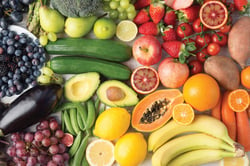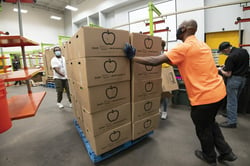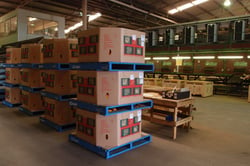Taco' Bout Freight: How to Avoid Costly Claims
Carrier Relations | Agency Ownership | Business Advice | Logistics | Transportation | Best Practices | Freight Management | Shippers | Freight Broker
Happy Cinco de Mayo, everyone! Armstrong couldn’t resist the opportunity to begin our post with a festive pun about freight claims, alongside our tips and tricks to avoid exposure to costly claims.
 In May, weather is warmer across the country and temperature-related claims are more common – especially for carriers handling produce loads. And you know what’s in those produce loads? Avocados, lettuce, tomatoes, limes, cilantro, peppers, and corn – many of the delicious ingredients for your Cinco De Mayo feast!
In May, weather is warmer across the country and temperature-related claims are more common – especially for carriers handling produce loads. And you know what’s in those produce loads? Avocados, lettuce, tomatoes, limes, cilantro, peppers, and corn – many of the delicious ingredients for your Cinco De Mayo feast!
Read on for some tips to help you develop an effective freight transportation plan for produce and temperature-controlled loads. Preparation, clear instructions, and an understanding of the goods you’re hauling will help you avoid significant losses for your business.
The Most Costly Claims and Commodities
Produce Packs a Punch
 Produce can be tricky to transport because it’s prone to spoilage, load shift, and allegations of adulteration under FMSA regulations. Often shipped over long distances, harvested goods are susceptible to variations in weather, temperature, and exposure while loading and unloading. Unfortunately, consumers have a growing intolerance for food product deterioration, which requires shippers and customers alike to enforce stricter standards. In a need-it-yesterday world, there are high expectations for maximum freshness making the margin of error on deliveries lower than ever.
Produce can be tricky to transport because it’s prone to spoilage, load shift, and allegations of adulteration under FMSA regulations. Often shipped over long distances, harvested goods are susceptible to variations in weather, temperature, and exposure while loading and unloading. Unfortunately, consumers have a growing intolerance for food product deterioration, which requires shippers and customers alike to enforce stricter standards. In a need-it-yesterday world, there are high expectations for maximum freshness making the margin of error on deliveries lower than ever.
 Most temperature-related claims aren’t covered by cargo insurance policies unless there is proof of reefer breakdown or malfunction. Additionally, most cargo insurance policies will not cover human error (or third-party negligence) if the temperature was improperly set by the driver. Ensuring the operator/driver understands the proper temperature for the load is critical. If you are unsure, or the freight documents are unclear about the temperature, ask. Finally, follow-up in writing about the temperature you were told, and maintain the freight documents for at least two years. Understanding best practices will help protect your company and ensure coverage by your insurance company if a cargo claim occurs.
Most temperature-related claims aren’t covered by cargo insurance policies unless there is proof of reefer breakdown or malfunction. Additionally, most cargo insurance policies will not cover human error (or third-party negligence) if the temperature was improperly set by the driver. Ensuring the operator/driver understands the proper temperature for the load is critical. If you are unsure, or the freight documents are unclear about the temperature, ask. Finally, follow-up in writing about the temperature you were told, and maintain the freight documents for at least two years. Understanding best practices will help protect your company and ensure coverage by your insurance company if a cargo claim occurs.
Priceless Packaging
We’ve all seen it: well-packaged products stand a lower chance of damage. Produce has unique requirements for packaging that can be found in the Blue Book Guide for Produce. Notably, produce should always be clean and dry before packing. Moisture advances food spoilage, and dirt is a breeding ground for bacteria. Lined or padded boxes with very little empty space (easily filled with crumpled paper or bubble wrap) help protect produce during transport. Consider providing holes for ventilation, which will help keep fruits and vegetables fresh during transport.
 Tape is also a critical packing component. Adhesives should be pressure sensitive and stick to all sides of the package, even when the temperature fluctuates. You might also consider additional packing supplies like foam coolers, gel packs, insulated liner, and thermal bags.
Tape is also a critical packing component. Adhesives should be pressure sensitive and stick to all sides of the package, even when the temperature fluctuates. You might also consider additional packing supplies like foam coolers, gel packs, insulated liner, and thermal bags.
While proper packaging can tack on extra costs, it’s better than losing valuable receiver customers and sacrificing relationships with reliable carriers who can’t assume the risk of hauling poorly packaged freight. If you arrive at a shipper’s warehouse and the product does not appear properly packaged, request repackaging. If the shipper cannot address your concerns, you are within your rights to refuse the load.
Proper Loading
 As you prepare to load your cargo into a truck, be mindful of factors that could lead to food contamination. This includes inspecting trucks for cleanliness, ensuring they have not recently transported waste, hazardous materials, animals, animal products, or any other prohibited commodity, as outlined in the FMSA. As always, be sure to comply with FMSA guidelines when it relates to clean and sanitized trailers.
As you prepare to load your cargo into a truck, be mindful of factors that could lead to food contamination. This includes inspecting trucks for cleanliness, ensuring they have not recently transported waste, hazardous materials, animals, animal products, or any other prohibited commodity, as outlined in the FMSA. As always, be sure to comply with FMSA guidelines when it relates to clean and sanitized trailers.
Carriers who accept produce loads should be mindful of appropriately loading cargo into the transport container or vehicle. Consider stacking liquids below dry goods to avoid leakage and spoilage. Uniform weight distribution is crucial to prevent contents from shifting or being crushed during transit. Try limiting empty space between boxes since that can lead to breakage.
Temperature Checks
Temperature management is critical to successful produce transport. Even the slightest fluctuations can lead to spoilage. Consider referencing this USDA Perishable Foods Transportation handbook or consult Blue Book’s Commodity Guide to determine the optimal temperature range for your cargo. Avocados, lettuce, limes, tomatoes, and sweet peppers are sensitive to temperature fluctuations and have their guidelines for optimal transport. An experienced reefer driver will be able to discern whether lettuce, for example, is best transported at the recommended 33 degrees or 34 degrees. Once lettuce freezes, it will be considered a total loss.
You may also consider shipping early in the week to decrease the chance of your cargo sitting over the weekend. Generally, shippers should allow 24-36 hours for transit – sometimes longer – which makes it necessary to plan for temperature control during this time.
Handling Freight Claims
 A freight claim is a claim that shippers can make against the carrier for damage, loss, or shortage of cargo while in the possession and control of a carrier. Receivers are responsible for immediately documenting any loss or damages that may have resulted from transport or delivery of freight. Claims become costly and confusing when receivers don’t correctly complete their paperwork or note the BOL with damage, shortage, or information regarding the protest. If the paperwork isn’t accurately notated, cargo insurance companies may refuse to pay a claim.
A freight claim is a claim that shippers can make against the carrier for damage, loss, or shortage of cargo while in the possession and control of a carrier. Receivers are responsible for immediately documenting any loss or damages that may have resulted from transport or delivery of freight. Claims become costly and confusing when receivers don’t correctly complete their paperwork or note the BOL with damage, shortage, or information regarding the protest. If the paperwork isn’t accurately notated, cargo insurance companies may refuse to pay a claim.
While receivers are typically encouraged to keep damaged freight until the claim can be made, some products – especially produce and temperature-sensitive items – require disposal or salvage. In this case, receivers should let the carrier know about the loss or damage right away. Carriers must be given a chance to mitigate their losses.
Want to Learn More?
As a leading U.S. freight broker, Armstrong works with more than 55,000 carriers and a network of over 7,000 customers. While we do our best to avoid stressful and potentially costly claim scenarios, loss, damage, and shortages are a fact of life in the fast lane. Through our claims department, agent owners have access to our dedicated team of representatives and free legal counsel to help navigate the claims process. Check us out at www.armstrongtransport.com and click Contact Us to learn more about our services.
About Emily M. Chiarizia, Esq.
Emily Chiarizia has been with Armstrong since 2018. As General Counsel, Emily is responsible for litigation management, internal policy development, compliance, risk management, contract negotiation, and the resolution of commercial cargo matters for Armstrong's 130+ agency offices.



.jpg)
